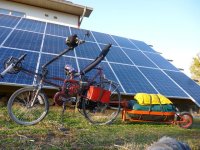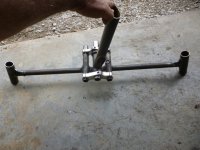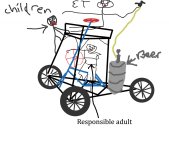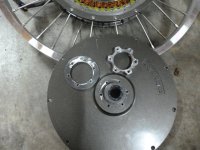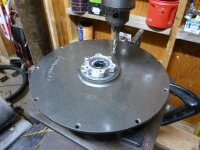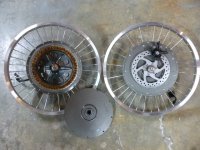llile
1 kW
- Joined
- Dec 18, 2010
- Messages
- 457
Clamping Station:
This is a big flat piece of scrap steel that I have had for years. Usually it lives under where I park my car in the garage, so it gets rustier every time I have a wet car. No big deal. I have made a simple system of clamps that I bolt onto the steel. I just drill a hole, tap it real quickly for 1/4-20, and set a bolt wherever I want a clamp to stay put. The whole thing is sitting on wood, so I won't drill into the concrete. The steel plate sits right in front of the welding station, between the drill press and the chopsaw, so I can quickly miter a piece of steel, clamp it in place, and weld it.
I wish I had a three dimentional clamping system, but two-dimensional is good enough. I can use a series of spacers (usually made of wood or conduit) to move things up on the "Z" axis. The flat steel gives a nice surface to use as a datum to measure where parts are.
If you don't clamp tubing before welding, you'll never get it straight. Lot's of people think they can eyeball it, holding one end and spot welding, or sticking a magnet on it. Never comes out straight. I have a buddy who also builds trikes, and he has yeat to build one that has all the wheels perpendicular to the ground the same angle. Very successful, he's used them for years of hevay riding, but they just don't look right.

This is a big flat piece of scrap steel that I have had for years. Usually it lives under where I park my car in the garage, so it gets rustier every time I have a wet car. No big deal. I have made a simple system of clamps that I bolt onto the steel. I just drill a hole, tap it real quickly for 1/4-20, and set a bolt wherever I want a clamp to stay put. The whole thing is sitting on wood, so I won't drill into the concrete. The steel plate sits right in front of the welding station, between the drill press and the chopsaw, so I can quickly miter a piece of steel, clamp it in place, and weld it.
I wish I had a three dimentional clamping system, but two-dimensional is good enough. I can use a series of spacers (usually made of wood or conduit) to move things up on the "Z" axis. The flat steel gives a nice surface to use as a datum to measure where parts are.
If you don't clamp tubing before welding, you'll never get it straight. Lot's of people think they can eyeball it, holding one end and spot welding, or sticking a magnet on it. Never comes out straight. I have a buddy who also builds trikes, and he has yeat to build one that has all the wheels perpendicular to the ground the same angle. Very successful, he's used them for years of hevay riding, but they just don't look right.





